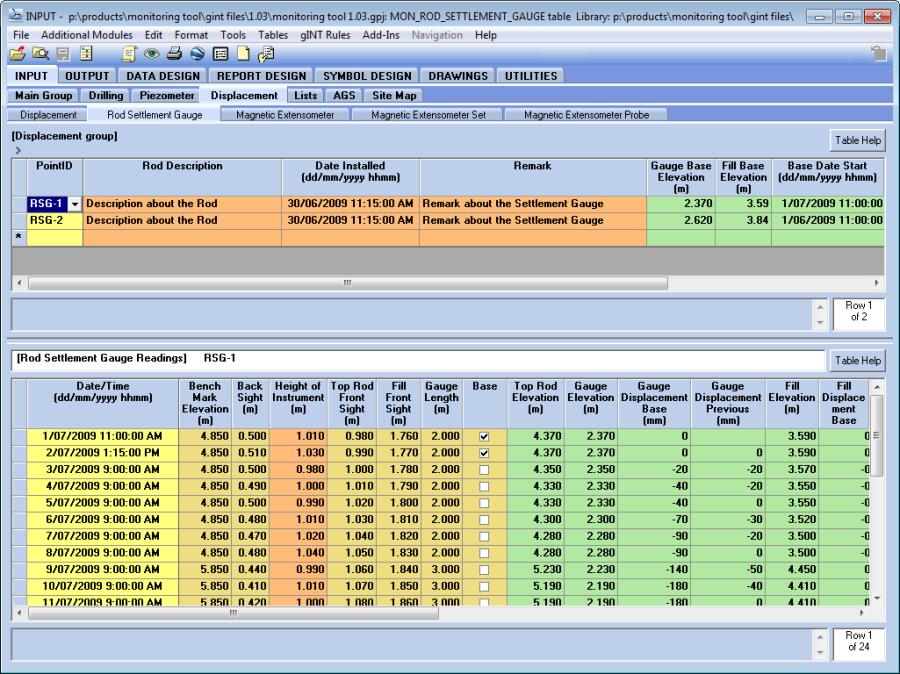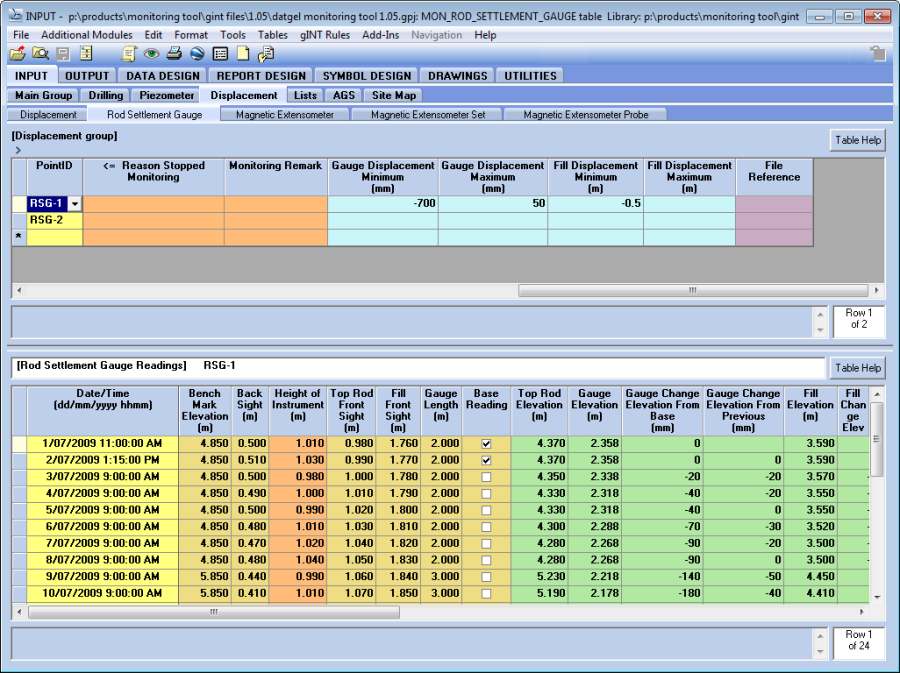Rod Settlement Gauges
Installation
The Rod Settlement_Gauge (upper) table is used to store the details of the settlement marker installation for a PointID.
Select an available PointID and enter the associated metadata in the Rod_Description, Date_Installed and Remark fields.
Monitoring Readings
The rod settlement gauge monitoring readings are recorded on the Rod Settlement Gauge (lower) table by entering the date and time when the monitoring occurred in the Date Time field and the survey information in the Bench_Mark_Elevation, the Back_Site, the Top_Rod_Front_Site, the Fill_Front_Site and (optionally) the Height_of_Instrument fields. The Gauge_Length value will be automatically populated with the same value as the previous record.
You may also enter data in the Top_Rod_Elevation and Fill_Elevation fields and leave the level run related fields blank.
The Top_Rod_Elevation, Gauge_Elevation, Gauge_Displacement_Previous, Fill_Elevation and Fill_Displacement_Previous values are calculated from the monitoring readings and the Gauge_Displacement_Base and Fill_Displacement_Base field values are calculated based on the base field value.
Base Reading
The base field value can be set in two ways:
- Automatically. If a recorded result is the initial reading for that rod settlement gauge installation, you can check the Base field on the Rod_Settlement_Gauge (lower) table to indicate this and the base reading will be displayed in the applicable Base value fields on the Rod_Settlement_Gauge (upper) table. If you check more than one reading as the base reading, then the value displayed in the Base field will be an average of these readings.
- Manually. If you wish to manually record the base values of the installation, then check the Manually_Set_Base field on the Rod_Settlement_Gauge (upper) table and enter this data into the base value fields. If you want to calculate these values, then leave these fields blank and don't check the Manually_Set_Base field.
Output
Output Options
The Gauge_Displacement_Minimum and Gauge_Displacement_Maximum fields are used to determine the minimum and maximum displacement axis values for the rod settlement gauge monitoring reports. The values entered into these fields override the values specified on the Monitoring Project Options table.
If a minimum and maximum value is not specified in the Gauge_Displacement_Minimum and Gauge_Displacement_Maximum fields on the Rod_Settlement_Gauge table nor in the respective fields on the Monitoring_Project_Options table, then the minimum and maximum reading values recorded in the Rod_Settlement_Gauge_Readings table are used to define the gauge displacement axis extents on the reports.
The Fill_Displacement_Minimum and Fill_Displacement_Maximum fields are used to determine the minimum and maximum displacement axis values for the fill materials surrounding the rod settlement gauge on the monitoring reports. The values entered into these fields override the values specified on the Monitoring_Project_Options table.
If a minimum and maximum value is not specified in the Fill_Displacement_Minimum and Fill_Displacement_Maximum fields on the Rod_Settlement_Gauge table nor in the respective fields on the Monitoring_Project_Options table, then the minimum and maximum reading values recorded in the Rod_Settlement_Gauge_Readings table are used to define the gauge displacement axis extents on the reports.
Output Reports
- Graphs | MON ROD SETTLEMENT GAUGE INSTALL A4P
- Graphs | MON ROD SETTLEMENT GAUGE INSTALL LETP
- Graphs | MON RSG VERSUS TIME PLOT A4P
- Graphs | MON RSG VERSUS TIME PLOT LETL
- Graphic Table | MON ROD SETTLEMENT GAUGE READINGS A4P
- Graphic Table | MON ROD SETTLEMENT GAUGE READINGS LETL


